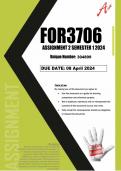FOR3706
ASSIGNMENT 2 SEMESTER 1 2024
Unique Number: 304899
DUE DATE: 08 April 2024
Terms of use
By making use of this document you agree to:
• Use this document as a guide for learning,
comparison and reference purpose,
• Not to duplicate, reproduce and/or misrepresent the
contents of this document as your own work,
• Fully accept the consequences should you plagiarise
or misuse this document.
Disclaimer
Extreme care has been used to create this
document, however the contents are provided “as
is” without any representations or warranties,
express or implied. The author assumes no
liability as a result of reliance and use of the
contents of this document. This document is to
be used for comparison, research and reference
purposes ONLY. No part of this document may be
reproduced, resold or transmitted in any form or
by any means.
, 0688120934
PREVIEW
Question 1
1.1 Locard's exchange principle, named after Dr. Edmond Locard, a pioneer in forensic
science, is a fundamental concept in forensic investigation. The principle states that every
contact leaves a trace. In other words, whenever two objects come into contact with each
other, there is an exchange of material between them. This principle forms the basis of
trace evidence analysis in forensic science.
Locard's exchange principle has significant implications in the field of forensic
investigation. It suggests that during the commission of a crime, the perpetrator will leave
behind physical evidence at the scene, and will also bring evidence away from the scene.
This evidence can take the form of fingerprints, DNA, fibers, hairs, or any other form of
trace evidence. Furthermore, it implies that a person entering a crime scene will also
leave behind traces of themselves, such as skin cells, hair, or fibers from their clothing.
Disclaimer
Extreme care has been used to create this document, however the contents are provided “as is”
without any representations or warranties, express or implied. The author assumes no liability as
a result of reliance and use of the contents of this document. This document is to be used for
comparison, research and reference purposes ONLY. No part of this document may be
reproduced, resold or transmitted in any form or by any means.




